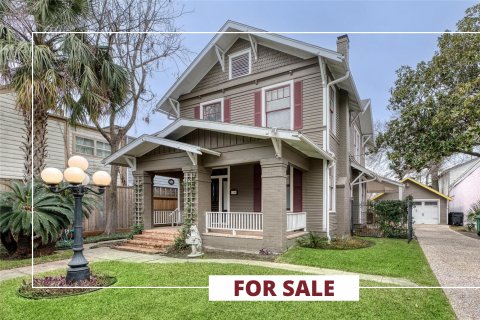Dallas’ Own Italian Villa is an Oak Cliff Marvel: Real Estate Tycoon Makes Temple-Like House Happen
BY Rebecca Sherman // 07.05.17From left, James Ferrara and David Griffin. The grand piano was one of Griffin’s first acquisitions after college in the 1980s.
In 2005, David Griffin and James Ferrara hosted a weeklong house party at a restored villa in Italy’s northeastern Veneto region.
Villa Saraceno, built in 1545, is one of 20 or so surviving estates designed by Andrea Palladio, one of the greatest Italian architects of the Renaissance. During their stay, Griffin and Ferrara became smitten with the villa’s high ceilings and classically proportioned, symmetrical rooms.
Despite its voluminous spaces constructed of solid stone, the house proved to be a surprisingly comfortable place to relax and entertain. This was no coincidence — Palladio often used a classical mathematical ratio, sometimes referred to as the golden mean, to create aesthetically pleasing spaces.
The Greeks used it to build the Parthenon. Palladio appropriated the calculation for the temple-like country homes he created for Italy’s gentry.
“Villas are such delightful houses to be in,” says Griffin, president of David Griffin & Company Realtors, which was founded in 1982 and markets architecturally significant homes. “I told James, ‘If we ever build a house of our own, let’s do a contemporary villa.’”
Two years later, they did just that. At the time, Ferrara was an associate with Buchanan Architecture. His desire to build a house with design roots in Italy went far beyond their stay at the Villa Saraceno; it was already coursing in his blood.
“I grew up in an Italian-American household with lots of siblings and a Sicilian grandmother, and we traveled extensively through Italy,” says Ferrara, whose passion for architecture was ignited on those early trips.
He studied Palladio’s work in graduate school at the University of Texas at Arlington, where he earned a master’s in architecture. Later, stints with Omniplan, Lionel Morrison, and Buchanan Architecture reaffirmed his passion and focus for contemporary architecture. Designing a classical temple, though, was never on his agenda.
“In architecture, the idea of building a Palladian villa is a loaded thing — it can sound pretentious,” Ferrara says. “But we wanted to do a deconstructed, contemporary version. The best of Palladio’s villas were simple and stripped down. That’s what we were going for: something solidly built with integrity that required very little maintenance.”
The couple found the perfect lot: a hillside setting in Oak Cliff’s Kessler Woods, overlooking five acres of nature preserve.
“It was very similar to the kinds of settings in the Veneto region, where Palladio had built his villas,” says Griffin.
Palladio often sited the villas on hilltops, and faced them towards the most dramatic views. At Villa Saraceno, the house aligns south to frame the craggy, snow-capped Dolomite Mountains.
In Dallas, Ferrara wanted their house to face north towards the expansive nature preserve and a grove of cedars below. Enter landscape architect David Hocker of Hocker Design Group, who was hired to create landscaping and water features that resonated with the surrounding nature preserve and were founded in traditional Italian design.
“I distinctly remember the first meeting with David and James, and them introducing me to their passion for Italian and contemporary architecture,” Hocker says. “I go back to Italy several times a year, because my wife is Italian. I am very familiar with the language of what they were talking about.”
As a young man, David Griffin loved to backpack throughout Europe, where the architecture was “like beautiful stage sets,” he remembers. “Space and design have always turned me on. That’s what made me get into real estate.”
The timeless, enduring quality of European construction methods never left his mind.
“In centuries past, things were built to last for all time. I hoped James and I could build a house that wasn’t as transient as 21st-century life has become, where everything is designed for obsolescence.”
Ferrara’s answer was an elegant, contemporary residence that feels as permanent and methodically considered as anything that might have come centuries before. The 3,600-square-foot structure, designed in an offset cruciform plan, has stalwart block walls finished in cast terrazzo, concrete and wide-plank walnut floors, and hot-rolled-steel storefront windows and doors.
Like houses long ago, it was designed for efficient crossventilation, and even the voluminous living room, with its 16-foot-high ceilings, can circulate a breeze and cool down quickly without air conditioning during temperate months. When needed, a high-tech geothermal cooling and heating system kicks in.
Ferrara consulted the golden mean to proportion the rooms, but he also put his own design stamp on the project, including a master bedroom that cantilevers over the back lot, appearing to float above the gardens.
He played with height and scale for drama, with a low-ceiling entry vestibule that leads into a soaring main living and dining area. This massive main room was a first for Ferrara, but they are de rigueur in villas and meant for entertaining.

“I’ve never designed a room like it for anyone, and when we were building it, some wondered if it might be too tall,” he says.
But like Villa Saraceno, it’s a comfortable and pleasant space, all the more enticing when the French doors are flung open to the terrace.
“One of the reasons we built the house with a room this large was to entertain,” Ferrara says. “We are involved with different philanthropic groups and we have lots of dinner parties. A great luxury is to have people over and to feed them well.”
The art of entertaining is a sentiment Ferrara’s Sicilian grandmother would have understood. For more formal dinners, a long B&B Italia dining table can seat 20, which is separated from the custom Bulthaup kitchen by a floating, walnut-paneled wall.
The kitchen has its own lounge seating for smaller groups, and sometimes Ferrara and Griffin switch out the two spaces, moving the dining table into the kitchen so that guests can talk and eat while Ferrara or an invited chef cooks.
“Growing up, the whole life of our house was centered on the kitchen,” he says. “My grandmother made all our bread, sauces, and pastas every Sunday. She made sausages from scratch. It’s very Italian to eat in the kitchen — we often had 12 to 15 people crowded in there for dinner.”
Long before Griffin and Ferrara ever considered building a contemporary villa, they had been collecting Italian furnishings for their previous homes, including contemporary pieces by B&B Italia and Max Alto and Italian antiques.
“I wanted to design the house around furniture we already had,” Griffin says. “It’s a distillation of experiences we’ve had and purchases we made during our travels.”
Interior designer Jennifer Haralson was enlisted to help pull it all together, re-covering and refinishing as needed and creating a furniture plan. Holding court in the living room is a grand piano, an acquisition Griffin made in the 1980s after graduating from Southern Methodist University.
“My mother was musical, and she pushed me to buy a piano,” he says. “I didn’t even have a decent sofa or table yet, but she insisted, saying, ‘If you have grand piano, your home is well-furnished no matter what else you have.’ And she was right.”
In the main living area, Haralson grounded the space with a palette of rusty-red and gray, playing off the home’s wood, concrete, and steel materials. The B&B Italia coffee table’s white-oak top was replaced with a darker wood, and the outdated gold fabric on the sofa was replaced with gray.
“David gravitates to vibrant Italian reds — he calls them Minnelli reds, because the director Vincente Minnelli often used the color in his movies,” says Ferrara.
A narrow palette helps provide cohesion and flexibility, but nothing feels contrived.
“One thing we didn’t want to do was ‘decorate,’” Ferrara says. “We wanted the furnishings to feel acquired. We’ve been collecting things all our lives for the homes we’ve lived in, but very few pieces worked together in this house until Jennifer recast them.”
As if cued by Minnelli himself, the terrace in winter is lush with red berries from possum haw shrubs, which David Hocker planted.
“In Italy, you’d often see hilltops planted with olive trees,” Hocker says. “Here, I’ve set off the pristine architecture on a hilltop of possum haw, and mixed it with seasonally changing native prairie.”
The result is a mix of buffalo grass, little bluestem, inland sea oats, and wildflowers such as Mexican hat, red poppies, horse herb, and pink primrose. Much like the formal gardens in Italy, Hocker designed terraces that follow the land’s natural changes in elevation.
A small “bubbler” at the top of the terrace funnels water down a series of concrete steps, flowing into a modern interpretation of a pond at the bottom. When it’s mild out, Ferrara and Griffin sometimes stage the lower terrace for movie night, with a film projected onto the fountain wall.
While the inspiration for the house and gardens may have started with a villa in Italy, Ferrara and Griffin have made it their own, expanding the boundaries of design that appeals to many cultures.
Ferrara says, “We frequently have people visiting from Europe and South America, and that’s the first thing they notice: that the way we live is more like what they are used to seeing. This house has a very universal appeal.”












































_md.jpg)
_md.jpg)


_md.jpg)
_md.jpg)



















_md.jpg)

_md.jpg)















_md.jpg)






_md.jpg)


